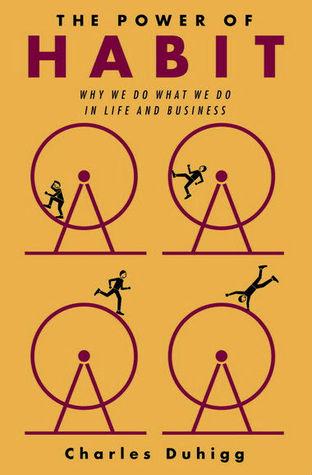Welcome to the second discussion session for The Power of Habit by Charles Duhigg. Last week, we discussed Part 1: The Power of Habit — Group Read — Part 1 Discussion. Today we’re discussing Part 2 which turns, somewhat, toward institutional habits and the ways that corporations use our habits to get us to buy more of their stuff.
 I’ll post my answers to the discussion questions here, but be sure to check the other linked posts and the comments for more opinions. We also have some discussion going at the Facebook group: New Year’s Resolution Reading Challenge on Facebook.
I’ll post my answers to the discussion questions here, but be sure to check the other linked posts and the comments for more opinions. We also have some discussion going at the Facebook group: New Year’s Resolution Reading Challenge on Facebook.
There will be more discussion about resolutions, goals, books, and The Power of Habit tonight, Wednesday, during our #NewYearBooks Twitter chat. I put up a post a couple of weeks ago about how to participate: New Year’s Resolution Reading Challenge — The Twitter Chat. Join us at 9pm Eastern / 8pm Central / 2am GMT.
 1. Chapter 4 of The Power of Habit discusses Keystone Habits. Sometimes an individual or organization can cause a cascade of positive change by focusing first on one small change. What situation in your life or organization have you seen a Keystone Habit work?
1. Chapter 4 of The Power of Habit discusses Keystone Habits. Sometimes an individual or organization can cause a cascade of positive change by focusing first on one small change. What situation in your life or organization have you seen a Keystone Habit work?
I’ve had the classic experience of exercise leading to healthier eating because I didn’t want to undo all of my hard work. In fact, I’ve had it multiple times. It’s always helpful, but it hasn’t always stuck.
I’ve watched other people take energy from a healthier lifestyle and transform it into decluttering and organization of their homes. I wish that would happen for me! At the moment, I’m getting some of it to go into productivity for my writing so I guess I’ll be happy with that.
2. Chapter 5 of The Power of Habit cites what, at first, seems to be conflicting studies on willpower. Spending willpower on one task makes it unavailable for other tasks. On the other hand, apparently, willpower can be learned and developed. Duhigg uses the metapor of willpower as a muscle to explain this–it can be fatigued but also strengthened over time. Does that metaphor work for you? What examples from your past illustrate fatigued willpower and strengthening willpower?
I’m not that keen on willpower. When people see that I’ve lost weight, they’ll often say “I wish I had that willpower.” But to me, it doesn’t feel like it was willpower when it finally clicked for me – it was much more about structures, strategies, and tricks. It’s a whole lot easier to resist chocolate cake if I arrange it so there is never any in my path.
But of course, sometimes my structures, strategies, and tricks don’t keep me away from temptation so there is some willpower at play to either turn away or request a small piece and enjoy every bite without letting it trigger further cravings.
Even now, my worst moments are when I’ve had what felt like a frightfully busy day where I’ve already expended large amounts of willpower to get through it. That makes late afternoons a bit of a mine field for me. Fortunately, by evening, my structures tend to kick into place and I cook and eat what’s planned anyway, nearly all of the time.
So, I guess I’ll go along with the muscle metaphor. But I still believe it’s easier to think through strategies and put structures into place that make it less likely that I’ll need willpower than it is to figure out how to strengthen my willpower muscle.
3. Chapter 6 of The Power of Habit tells a couple of scary stories about bad ad hoc institutional habits that led to catastrophic failure. There’s a hopeful bit at the end — institutions in crisis can change in ways that seemed impossible before. When have you seen an individual or organization adopt new habits after a crisis?
The crisis that started my weight loss journey was a 40-pound gain in a year, after I’d lost the same 40 pounds slowly in the previous two years. That was enough to convince me that I was never going to make this happen without consistent, determined, lifelong strategies and it was time to put them in place.
4. Chapter 7 covers the somewhat creepy ways that corporations manipulate consumer habits. What surprised you about these stories? Does this change anything about the way you view marketing and how you will look at advertisements and other marketing materials you receive?
I tend to ignore most marketing materials I receive or am exposed to. Or, at least, I think I do. After reading this chapter, I’m not quite so sure I’m as good at spotting when I’m being marketed to as I think I am.
This quote worried me:
“Consumers sometimes act like creatures of habit, automatically repeating past behavior with little regard to current goals,” two psychologists at the University of Southern California wrote in 2009.
I feel better about seeking out small businesses and local businesses that have good products and small marketing budgets so that I’m being consistent with current goals and not getting derailed.
5. Has the Power of Habit changed anything about the way you are doing or seeing things since you started reading the book?
As I was making some plans and changes to my time and task management systems with the New Year, I remembered the section in Chapter 5 about the people recovering from knee surgery. Patients who made plans to get themselves through the moments where they would be most likely to quit (when pain was greatest) experienced the quickest recoveries. I made a list of things that would signal that I was beginning to let my energy for my new system flag and another list of things to try when that happens. I’m very hopeful. Looking back, I know that I’ve failed to keep a time and task management system going in the past by not having a plan in place to handle potential failure points.
I’m looking forward to your thoughts on Part 2 of The Power of Habit.
